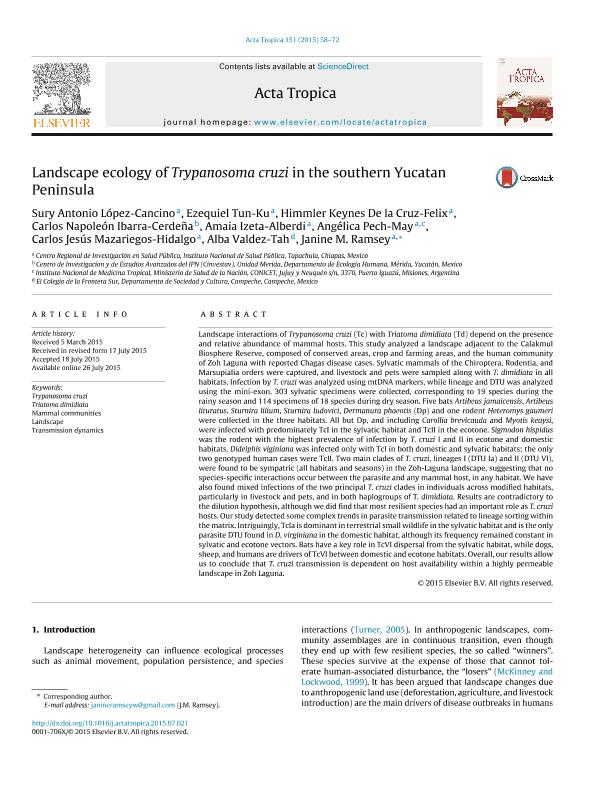Artículo
Landscape ecology of Trypanosoma cruzi in the southern Yucatan Peninsula
López Cancino, Sury Antonio; Tun Ku, Ezequiel; De la Cruz Felix, Himmler Keynes; Ibarra Cerdena, Carlos Napoleón; Izeta Alberdi, Amaia; Pech May, Angélica del Rosario ; Mazariegos Hidalgo, Carlos Jesús; Valdez Tah, Alba Rocio; Ramsey, Janine
; Mazariegos Hidalgo, Carlos Jesús; Valdez Tah, Alba Rocio; Ramsey, Janine
 ; Mazariegos Hidalgo, Carlos Jesús; Valdez Tah, Alba Rocio; Ramsey, Janine
; Mazariegos Hidalgo, Carlos Jesús; Valdez Tah, Alba Rocio; Ramsey, Janine
Fecha de publicación:
03/2015
Editorial:
Elsevier Science
Revista:
Acta Tropica
ISSN:
0001-706X
Idioma:
Inglés
Tipo de recurso:
Artículo publicado
Clasificación temática:
Resumen
Landscape interactions of Trypanosoma cruzi (Tc) with Triatoma dimidiata (Td) depend on the presence and relative abundance of mammal hosts. This study analyzed a landscape adjacent to the Calakmul Biosphere Reserve, composed of conserved areas, crop and farming areas, and the human community of Zoh Laguna with reported Chagas disease cases. Sylvatic mammals of the Chiroptera, Rodentia, and Marsupialia orders were captured, and livestock and pets were sampled along with T. dimidiata in all habitats. Infection by T. cruzi was analyzed using mtDNA markers, while lineage and DTU was analyzed using the mini-exon. 303 sylvatic specimens were collected, corresponding to 19 species during the rainy season and 114 specimens of 18 species during dry season. Five bats Artibeus jamaicensis, Artibeus lituratus, Sturnira lilium, Sturnira ludovici, Dermanura phaeotis (Dp) and one rodent Heteromys gaumeri were collected in the three habitats. All but Dp, and including Carollia brevicauda and Myotis keaysi, were infected with predominately TcI in the sylvatic habitat and TcII in the ecotone. Sigmodon hispidus was the rodent with the highest prevalence of infection by T. cruzi I and II in ecotone and domestic habitats. Didelphis viginiana was infected only with TcI in both domestic and sylvatic habitats; the only two genotyped human cases were TcII. Two main clades of T. cruzi, lineages I (DTU Ia) and II (DTU VI), were found to be sympatric (all habitats and seasons) in the Zoh-Laguna landscape, suggesting that no species-specific interactions occur between the parasite and any mammal host, in any habitat. We have also found mixed infections of the two principal T. cruzi clades in individuals across modified habitats, particularly in livestock and pets, and in both haplogroups of T. dimidiata. Results are contradictory to the dilution hypothesis, although we did find that most resilient species had an important role as T. cruzi hosts. Our study detected some complex trends in parasite transmission related to lineage sorting within the matrix. Intriguingly, TcIa is dominant in terrestrial small wildlife in the sylvatic habitat and is the only parasite DTU found in D. virginiana in the domestic habitat, although its frequency remained constant in sylvatic and ecotone vectors. Bats have a key role in TcVI dispersal from the sylvatic habitat, while dogs, sheep, and humans are drivers of TcVI between domestic and ecotone habitats. Overall, our results allow us to conclude that T. cruzi transmission is dependent on host availability within a highly permeable landscape in Zoh Laguna.
Archivos asociados
Licencia
Identificadores
Colecciones
Articulos(CCT - NORDESTE)
Articulos de CTRO.CIENTIFICO TECNOL.CONICET - NORDESTE
Articulos de CTRO.CIENTIFICO TECNOL.CONICET - NORDESTE
Citación
López Cancino, Sury Antonio; Tun Ku, Ezequiel; De la Cruz Felix, Himmler Keynes; Ibarra Cerdena, Carlos Napoleón; Izeta Alberdi, Amaia; et al.; Landscape ecology of Trypanosoma cruzi in the southern Yucatan Peninsula; Elsevier Science; Acta Tropica; 151; 1; 3-2015; 58-72
Compartir
Altmétricas



